Welcome to the fifth step in our free professional learning series on building your PLN.
The aim of this step is to:
- Explain what a blog is.
- Unpack the benefits of using blogs as part of your PLN.
- Describe some of the ways people keep up to date with blogs.
- Explore how to use blogs as part of your PLN.
Blogs play an important role in most educators’ PLNs and making blogs part of your PLN is more than just publishing posts on your own blog. If you don’t see yourself setting up your own blog, there are many benefits to simply reading, commenting, and sharing other people’s blogs.
What Is A Blog?
Blogs have been mainstream for well over a decade, so you might be very familiar with what a blog is (you’re reading a blog right now!).
However, let’s take a moment to define what exactly a blog is as the term continues to evolve.
Over recent year, the lines between blogs, websites, ePortfolios, and other online spaces have been blurring.
| BLOG | WEBSITE | PORTFOLIO |
|---|---|---|
|
Dynamic Community Feedback and interaction (comments, sharing, RSS, and subscription) Typically journal-like |
Static information General term for online space — complex or simple |
Scaffolding, showcasing or organization of student work Typically over a period of time (years) |
A blog is simply a website, although traditionally a website will have been more of a static space.
What makes a blog different than a simple website?
- A blog traditionally would be updated fairly regularly and display posts in reverse chronological order.
- Comments have always been a key feature of blogs, providing an interactive space.
- Most blogs have pages where some key information is housed that isn’t updated very frequently (for example, an About Me page).
Nowadays, some people have a website that has a blog component; the home page doesn’t change but readers can click on a tab to view a regularly updated blog.
An example of this is Langwitches’ “Online Hub”. This is a website that displays Silvia Tolisano’s professional portfolio and there is a blog section that readers can navigate to from the front page.
An Introduction To Blogging Video
This video also provides a simple overview of what a blog is.
Reasons Why Educators Blog
The main reasons why educators have personal/professional blogs include to:
- Share information and tips with other educators.
- Collaborate with a global audience. Increased collaboration with others leads to greater innovation and new perspectives.
- Reflect on their learning or their teaching/work practices.
- Learn how to blog themselves so they can use blogs effectively with their students.
Refer to The State of Educational blogging in 2017/2018 for more information on why educators use blogs.
Your personal blog extends your relationships outside of your school and allows you to connect with global educators who all willingly help each other.
Using Blogs As Part Of Your PLN
Sue Waters, who is the backbone of Edublogs has reflected on her own experiences of blogging.
I’m sure that lots of people would be totally surprised by the fact that initially I really struggled with the concept of blogging — ‘Why would anyone blog and why would anyone read their blogs?’
It took almost a year from being shown what a blog was to becoming a blogger.
The online tools I used before blogging were excellent for sharing information. But blogging gave me what they lacked; the ability to reflect, collaborate, exchange ideas, and connect with other people.
Ultimately, blogging completely changed my life; it’s the reason why I’m now employed to do the work I do and blogging helped me build a strong PLN.
It’s also important to remember that not everyone who makes blogs part of their PLN are bloggers themselves. It’s really up to you!
Some educators prefer to read and comment on other people’s posts while other educators also have their own personal blog.
If you have a vague thought in the back of your mind about starting your own blog but you’re not sure if it’s for you, hopefully Sue’s words above remind you that you can jump into blogging with some reluctance and you may be pleasantly surprised.
What have you got to lose?
Tips For Building Your PLN Via Blogs
The key components to making blogs part of your PLN are really simple:
- Read and comment on other people’s blog posts. Then share anything that resonates with you with your PLN (e.g. on Twitter).
- Publish posts on your own blog to reflect your thoughts, ideas, and/or to share resources. Remember, this is optional but keep it in mind!
Like everything, there are tips that’ll both save you time and make you more effective.
Reading Blog Posts
There are thousands of educators out there who are regularly publishing on their own blogs. Many of these blogs revolve around specific topics, interests, or subjects areas. Others are more general reflections on all areas of education.
Reading blog posts is an important part of connecting with other educators. But how do you keep up to date with your favorite blogs and know if something new has been published?
There are three main ways you can keep up with your favorite blogs:
- Email subscription or email newsletter if available
- RSS feed (using a tool like Feedly)
- Social media and curation tools like Flipboard
Interestingly, when we did a quick poll of our Edublogs community in July 2018, 61% of respondents indicated that their favorite way to keep up to date with the blogs they like to read is via social media.
This might demonstrate that people are okay with consuming information serendipitously (there’s no guarantees they’ll see posts on social media). To avoid being swamped by emails, perhaps people choose to subscribe to only their very favorite blogs in this way. Feel free to tell us what you think in the comments!
Email Subscription
Many bloggers have an option to be notified via email when they publish something new. This might be via a simple email subscription widget on the sidebar of their blog. In this case, you’ll receive an email automatically to alert you to new posts.
It’s also becoming more common to see educators (and bloggers in general) create their own personal email newsletter to keep readers up to date. This might be sent out every time they publish something new, or there might be a weekly or monthly summary email.
Check out the sidebar of your favorite blog and look for a sign-up box.
RSS Feed (Feedly)
One of the easiest ways to keep updated with posts from your favorite blogs is to subscribe to their RSS feed using Feedly. The free version of Feedly allows you to follow up to 100 sources which should be enough to keep you busy!
Refer to these step-by-step instructions on how to set up Feedly.
This short video by Joshua Essary explains how to get started with Feedly.
There are other similar tools, but Feedly is one of the most popular.
Here are just a few popular education blogs you can subscribe to using Feedly.
Click here to open this spreadsheet in a new window.
Social Media And Flipboard
If you follow your favorite bloggers on Twitter, no doubt you will see them announcing when they have something new on their blog. Of course, there are no guarantees that you will always see this.
Another option Sue Waters uses on her mobile devices is subscribing to her Twitter timeline and Twitter hashtags using Flipboard.
This pulls all the links shared on Twitter into her Flipboard account in a magazine format where it’s easy to read, share, and comment on articles shared by her network.
You’ll find detailed step by step instructions on how to set up Flipboard here.
Watch this video to see how Sue uses Flipboard.
Commenting On Posts
Your commenting skills and how you engage in comments with others on blogs posts is one of the most important, and often overlooked, aspects of using blogs as part of your PLN.
The comment section is where the deep learning, questioning, and reflection can occur. Comments turn your blog from a static space into an interactive conversation.
Commenting Tips For Bloggers
1. Don’t just lurk — comment!
Of course you’re probably not going to comment on every blog post you read, but every now and then make the concerted effort to scroll down to that comment box and type a response, ask a question, or share your own insights. Your comments don’t have to be long to make an impact.
Remember, being part of a PLN is about giving as well as receiving. Taking the time to begin conversations will pay off!
2. Approve comments quickly
If you’re a blogger and someone leaves a comment on your post, make sure you approve the comment quickly (if you moderate comments).
There’s nothing more annoying to a reader to see that their comments haven’t been published. They might forget about it and not check back to see your response.
3. Always respond back to readers on your own posts
If readers have made time to comment on your posts the very minimum you should do is respond back to your readers (ideally each reader) in the comments on your post.
This is very important for building your blog’s community; it demonstrates that you value your readers and their input.
Below is an example of replying back to a comment using threaded comments:
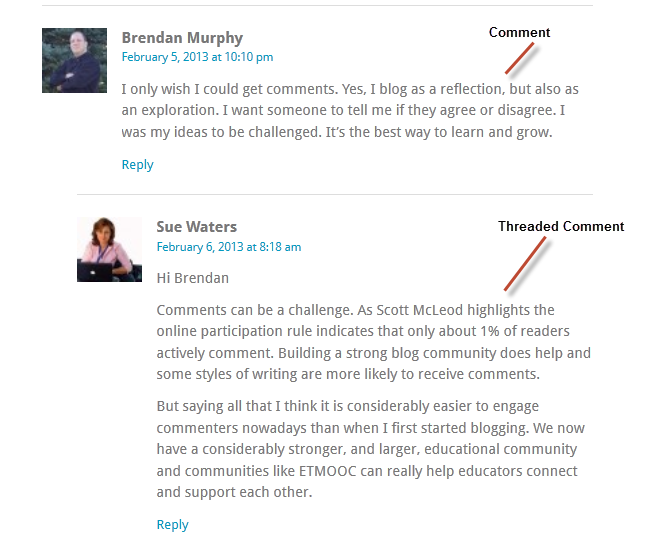
4. Use the Subscribe to Comments option
If a blogger provides a subscribe to comment option, then make sure you select this option when leaving a comment, so you’re notified by email of any follow up comments.
It’ll make your life easier. 🙂
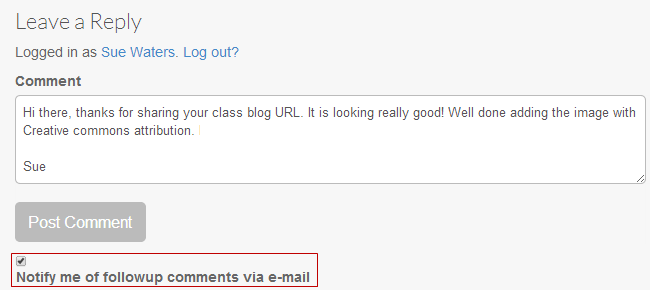
Set Up Your Own Blog
If you’ve never blogged before, hopefully you’re reading this with the open mind to consider starting a blog now or even in the future.
But there are so many blogs out there! Why should I start one?
This is a common concern for people contemplating whether to start their own blog. They might feel like there is so much noise and so many blogs that are already established. They wonder what they could possibly have to add to the community?
We can assure you, you do have something worthwhile to share!
You are the only you. Your unique perspectives could be exactly what someone else needs to hear.
As George Couros has said,
My best advice…write for you and don’t overthink. See every blog post as a rough draft to something you are building over time, not a college term paper.
The more you do it, the better you will become.
The better you become, the easier it will be.
Be kind, be thoughtful, but don’t overthink. It is probably holding you back for inspiring someone else, and probably surprising yourself.
Still not convinced?
Check out Obvious To You, Amazing To Others by Derek Sivers.
A Blog Is Your Online Home
There are many advantages to blogging.
George Couros’ three reasons for blogging are shared by thousands of educators worldwide.
One of the great advantages of having your own blog when you’re setting up your PLN, is that it’s your online home.
Maybe you’ll discover a really cool tool, article, or resource. You could write about it (and share your learning with others).
Perhaps you’ll connect with some like minded teachers and possibly start some sort of collaboration. This would be perfect to blog about.
Even if your blog doesn’t really have an audience, a blog can be a fantastic place to keep track of all the work you’re doing both online and offline.
Your blog can also become an excellent professional portfolio. This can be an advantage when you’re trying to demonstrate who you are and what you’re passionate about for future career opportunities.
As Stephanie Thompson pointed out on her blog,
An effective personal learning network and a willingness to share has enabled me to enjoy some incredible learning opportunities both inside and outside the classroom in the last few years. When I look back, even getting that first job offer in a market saturated with teaching graduates was directly attributable to an online professional presence.
What Platform Should I Blog On?
If you’re still reading, hopefully you’re thinking that setting up a blog is a possibility.
So you might be wondering where to set up your blog?
There are many choices.
Edublogs and CampusPress are powered by a customized version of WordPress. WordPress is the tool of choice for the large majority of professional bloggers and online publishers. In fact, over one-third of the entire web is powered by WordPress.
It’s highly customizable, export-friendly, and it works!
It’s free to sign up for a blog at Edublogs and it’s the world’s most popular platform for educational blogging. Just go to https://edublogs.org/ to sign up!
Read more about the advantages of using a WordPress based platform like Edublogs in this post.
How Do I Start A Blog?
Ready to start your blog? We can help with that.
Our Personal Blogging Series takes you step-by-step through the process of setting up your own personal educator blog. It includes links to other educators’ blogs so you can see how they use their blogs.
Already dabbling with blogging? You’ll find our tips for writing more effective blog posts here.
Conclusion: Why Blog When You Can Microblog?
There’s a lot you can learn from getting involved in the blogging community whether that’s writing your own posts, or simply reading and commenting on other blogs.
However, this takes a certain amount of time. So what is the benefit of using blogs as a part of your PLN, as opposed to a tool like Twitter or other forms of social media?
Simply put, the more you put in the more you get out. Blogging allows you to dig deeper and really form strong connections with others. You’re not limited to 280 characters like on Twitter. You can write thousands of words if you like! Or at other times a few short sentences might suffice. The choice is powerful.
Tom Barrett created the following diagram for a post where he explored the impact of microblogging.
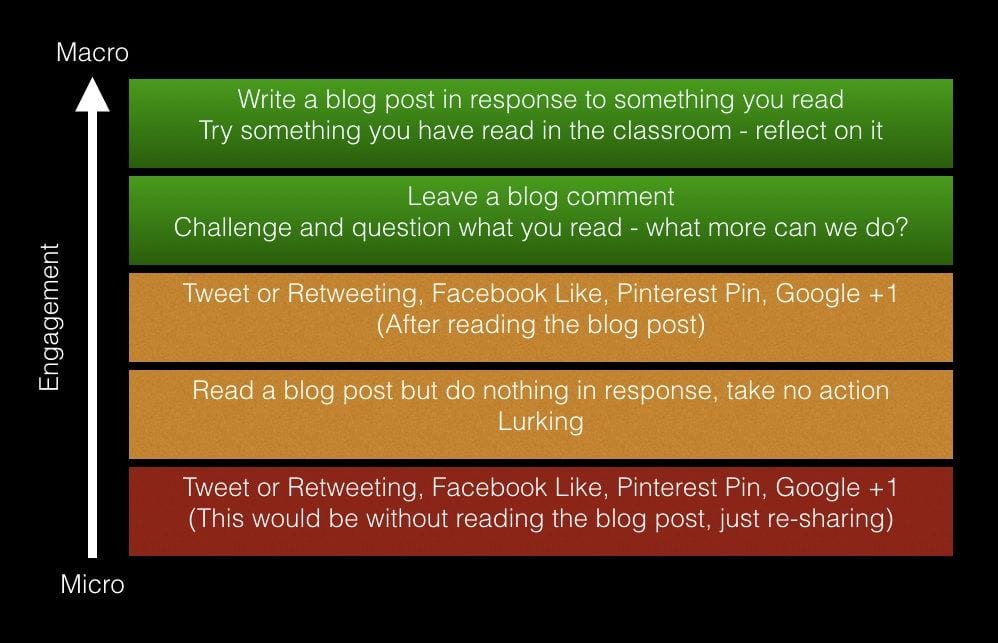
Tom Barrett said,
There is nothing wrong with the amber lit retweeting and sharing, but for many people we are sharing in an attempt to have the most impact on others. The micro engagement that occurs as people share without reading and, reposting content without engaging any further, is much more prevalent than the more in depth discussions of 10 years ago.
There’s definitely room for the amber, but think about the benefits that the green could bring to your professional life too.
Like all other aspects of building a PLN — what you get back is directly related to what you put in!
In an article for EdTech Review, Saomya Saxena explained how blogs are an essential part of an educator’s PLN,
Hence, blogs are one of the most significant online tools that can help you build your professional and personal learning networks. There’s no limit to the people we can connect with, be inspired by and stretch our professional wings with and blogging offers a great opportunity to do that. I feel that, blogs will be a must for anyone who wants to develop a PLN for himself, since it is the most open, creative and free way of sharing knowledge and expressing oneself. So embrace blogging in your daily lives and grow your learning networks personally as well as professionally.
Definitely food for thought.
Your Task
We’d like you to add your voice and ideas to our ongoing conversation about PLNs by undertaking one or more of these challenges:
- Share a link to an educator’s blog that you enjoy reading. Tell us what the blog is about what you get out of following the blog. Also, mention how you stay updated with the blog. Do you just check from time to time? Do you have an email subscription? Or do you use a tool like Feedly or Flipboard?
- Set up Feedly and/or Flipboard, referring to the instructions in this post. Leave a comment to tell us how you went setting up the tool. Let us know who you subscribed to and why.
- Write a post on your blog with your own thoughts about using blogs as part of your PLN. Please include @edublogs if you tweet your post so we can share your post with our network. Leave a comment with a link to your post so we can read it! In your blog post, you might like to cover topics like:
- How do you use blogs as part of your PLN?
- What tips do you have for newbies?
- What did you learn about using blogs for building a PLN that you didn’t know?
- What do you like/not like about Feedly, Flipboard, email subscriptions, or blogs?
Also feel free to leave a comment to ask any questions or share your tips.
How to leave a comment: Scroll down to find the comment box. Write your comment, then enter your name and email address (email addresses are not published). Enter the anti-spam word. Press submit and we will moderate your comment ASAP.
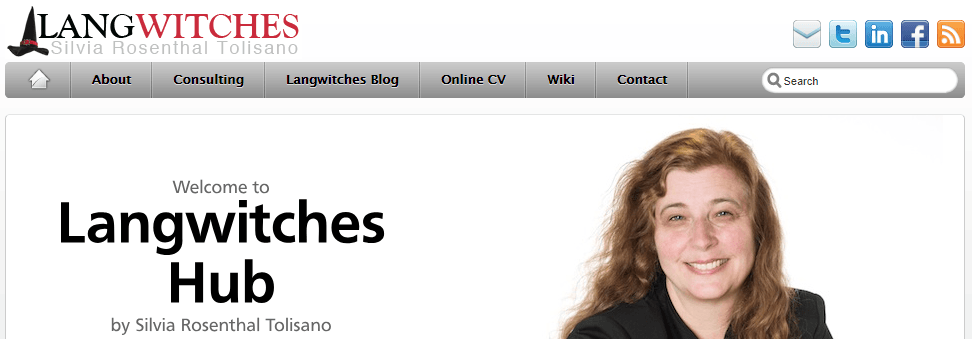
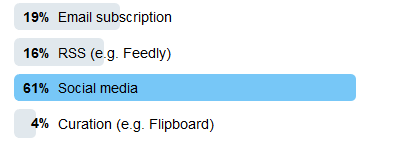
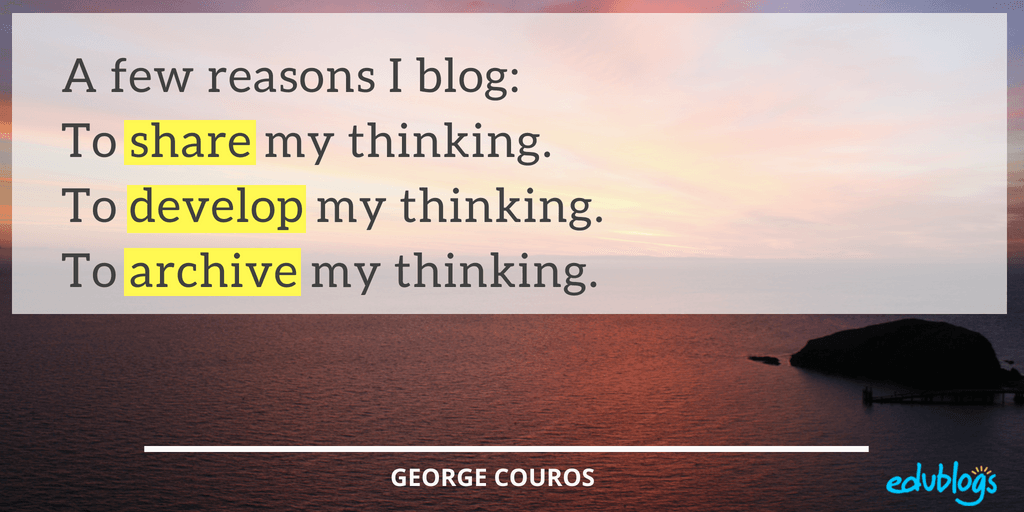
https://peacefieldhistory.com/ is a blog I follow for creative ways to teach social studies. I stay current with the blog by following her Instagram page as well and she notifies her followers of any updates to her blog. She recently updated her blog with ways to make remote learning engaging which was a post that I found to be especially useful during these times.
I looked at the blog Shake Up Learning by Kasey Bell and really liked some of the blogs that she wrote. One particular one that related to my current instruction was the blog called “Google Tips for Remote Learning” since my school is currently fully remote. This blog listed common problems different Google platforms, such as Google Slides and Google Meet, and how you can easily solve them. Here is a link for the blog: https://shakeuplearning.com/blog/10-google-tips-for-remote-learning/
Right now I am just checking the blog but I might subscribe to emails.
I already had Feedly because I use it to follow the news (when I remember to read it). However, I just added several teacher blogs to my feed. After logging in, I searched for some blogs from the excel sheet mentioned above. Then, I followed their blogs on Feedly. I created a new feed called “Education” to organize them. I started following Pernille Ripp and Cult of Pedagogy because I am familiar with them from various searches on the Internet.
https://www.edutopia.org
I enjoy searching through this site. Tremendous amounts of information/blogs are available covering a large range of educational topics. Great resource.
I set up Flipboard on my phone, I am enjoying it already. I am always looking for more to read and learn about. I still need to figure out how to connect my other social media to it, but so far I am enjoying the content I’ve chosen so far. I have followed Brain Based Teaching and Educational Technology, I have enjoyed the flips that I have read. I think the more familiar I become with Flipboard, the more I will follow and add magazines to my personal page. Thank you for sharing how to do this.
In creating a Flipboard account, I personally found that I like the possibility of following a hashtag more than the individual blogs. I think that the generalized hashtags of #educationaltechnology and #education are really great because they are so vast and you can find such a great deal of wonderful information in the different stories that populate the screen.
https://www.weareteachers.com/
This is a blog site that shares lesson plan ideas, classroom ideas, and many other things. It would definitely be useful as an educator to check out!
https://shakeuplearning.com/blog/
I really like this blog it is called the “Shake Up Learning blog”. It has a lot of information within different contents, such as: podcasts, courses, and written blog entries. It is very current as well!
https://sjg117.edublogs.org/2020/10/01/how-i-feel-about-blogs/
This is what I think about blogs.
Here are my thoughts on blogs:
https://sarahklein14.edublogs.org/wp-admin/post.php?post=10&action=edit
I signed up for a blog spot today. A blog I enjoy reading is https://drjharbour.blogspot.com/2020/09/does-tv-impact-how-we-view-disabilities.html?spref=fb&fbclid=IwAR3eqL9cZbwEsAcQrdxGIamy3d9tLe_LISjRApHOTS5_1CJNyopxprQbMyA
The link to the “Cool Cat Teacher” blog is the following: https://www.coolcatteacher.com/feedback-tips-for-blended-and-online-learning/
This is something that I check occasionally, but it works for me to get some information and motivation when needed. She also has other individuals on the blog to provide new information and provide a different perspective which is nice. Especially with all of us adjusting to online learning and the challenges that can bring, I think it is important to find resources that inspire us and keep us motivated.
I set up Feedly and installed the app on my iPad. It was quick and easy, and I subscribed to three education blogs – EdSurge, TeachThought, and The Edublogger – to learn about best practices and trends in education.
http://www.freetech4teachers.com
I really like this Blog by Richard Byrne. It is all about technology and gives lots of tips. I’m finding it to be especially relevant right now.
https://blogs.edweek.org/teachers/teaching_ahead/serving-low-income-students/
This is a blog for teachers teaching children in poverty. This blog gives insight to some of the best techniques teachers have used and seen work in their school. Being an aspiring teacher for children in poverty and having been a student in a school like that I feel this blog is great for me and I stay updated by checking time to time. Although it hasn’t been updated in some time I like to look at past approaches that have worked and think from my experience in schools like that as a student.
I set up a Flipboard account, and I followed hashtags like the following: #education #teaching #technology #educationaltechnology #learning #students #onlineeducation. I believe following these will help me stay up to date and provide me with information that will help me be an even better teacher. I am already enjoying the posts that are coming up.
https://www.thatsundayschoolgirl.com/know-it
She puts out a weekly commentated Sunday School lesson each week. If you subscribe she will send you weekly updates. No I do not have a Feedly set up yet.
The educator’s blog that I enjoy reading is https://www.themeasuredmom.com/. I stay updated by email subscription. I have learned tips for helping kids sound out words and the pre-reading skills kids need before they are ready to sound out words. I also learned several approaches to teaching kids to sound out words.
Lynette Moffett
I signed up for Feedly and started following Free Technology for Teachers. This is an area that I am not up to date with and I think this Blog will help me to stay current.
One blog that I subscribe to via email is Shake Up Learning by Kasey Bell https://shakeuplearning.com/blog/ Kasey Bell has fantastic ideas for any teacher, but I love the connections I can make with my instructional technology coaching. Not only does she have a blog, but she also offers a podcast and even courses.
Never thought that I would read or use a blog. I would find something on Pinterest of interest then save and open the link and it took me to someone’s website. Then it asked me to sign up for emails and newsletters. Little did I realize or make the connection that I was a lurker!
I set up a Feedly account and have two boards. In my writing board I am following Two Writing Teachers and Tricia Ebarvia – both of which have excellent innovative resources that I can share with my teacher candidates. My students struggle with writing themselves so these blogs will help me bring more joy to their personal writing and provide great examples for when they are in their own classrooms. I also started a board called Teaching Technology in which I am following Caitlin Tucker and Teacher Tech. These feeds will help me improve my own technology skills and bring digital literacy into the classroom of my undergraduates.
I like to check out http://www.learningismessy.com for information and understanding that learning is not one size fits all. I think it is important to stay up to date with information and ideas for our at risk youth. I also like to follow http://www.organizedclassroom.com to help me keep the funtionality and flow of my classroom. I think it is important to make the space for kids the best possible for learning. I have them bookmarked and just give them a check from time to time.
I am so sorry – I am having computer problems and I tried to delete this. What I meant to type in response to you was that I love The Organized Classroom. I recommend this blog to my student teachers because it has great content. I am not familiar with learning is messy but I am excited to investigate that one. Thanks for sharing~
One blog that I enjoy following is Mindshift’s blog at https://www.kqed.org/mindshift/. I check it from time to time but I also follow them on my professional Twitter.
I decided that I would check out some education blogs. I found a huge list of different blog sites. There was one blog that I really enjoyed reading called Teach Junkie. https://www.teachjunkie.com/about/
(whattheteacherwantsblog.com) is a blog about Tips for teachers, parents, and anyone in between! What the Teacher Wants. it was started in 2010 as a way for Rachelle to post pictures of her classroom and share her teaching ideas.
I took a look at https://www.excitededucator.com/ and I was amazed to see a post that had such an emphasis on coding. I think that coding is something anyone can do regardless of their age, and especially regardless their gender. I love seeing the norms broken down and introducing this to young people.
I follow
Rodney Robinson
@RodRobinsonRVA
Following
2019 National Teacher of the Year Philadelphia Eagles Fan **Tweets are mine and not representative of any organization**
I get various informaiton about schools, upcoming events, and other things related to education by following him on my Twitter feed.
I looked at the Shake Up Learning blog (https://shakeuplearning.com/blog/). This is one of the more current blogs (2014). The blog shares content in a lot of formats. It has the traditional written entries, but it also has podcasts, courses, webinars, certifications and more. I just bookmarked the blog and I signed up for the subscription via email.
While there are a lot of new and interesting blogs I have discovered over the past few days, the one that has piqued my interest is Free Technology for Teachers (https://www.freetech4teachers.com/), by Richard Byrne.
From what I have seen so far (there is still much I have yet to explore), he offers information on interesting technology for teachers, as well as tips and tricks and/or tutorials on how to use technology in ways I wouldn’t necessarily have thought of. He also has a podcast you can follow (I checked out an episode on Spotify, but I think there’s also a video version on YouTube).
I have only just set up Feedly this morning, but this seems like a great space to keep up with all my varied interests; I’ll just have to be careful not to go down the rabbit hole for long periods of time.
Blogs are not new, but they are new to me. At this time, I don’t feel comfortable in doing my own blog, but I will be more involved with finding blogs that I am interested in and find informational. Tips for newbies, wow just when you think you are tech savvy you realize your not. All this information about blogs and how to use them is amazing. I learned very fast that it is about gathering information and sharing information. I just have to work on feeling comfortable about sharing and I think that will come with the more I use them. I haven’t used Feedly or Flipboard enough to have an option on what I like and don’t like. At this time, I just enjoy reading and searching. That is part of the fun.
I set up a feedly and looked through quite a few different educational blogs. I found a few that I think I will really enjoy and learn from. One of those is Emerging Education Technologies. I think it’s important to stay in the know about the different technologies the are available to us these days to teach our students and maybe I can implement them in my own classroom. I’m excited to read more.
I set up feedly using my VCU school email. I created a feed for education and followed some of the popular twitter accounts mentioned earlier because they have blogs as well. I hope to use their blogs and twitter accounts to learn from when I am a connected educator myself. I have started connecting, but I cant wait to get into my own classroom. I want to start sharing instead of lurking.
The link to the educator’s blog that I enjoy reading is https://www.themeasuredmom.com/. This blog has ideas for teachers and parents. The blog gives educators resources on how to teach phonics and other skills. Teachers can print out the resources. I use the resources to help create learning centers. I stay connected with the blog through email.
When I was student teaching in a lab school on my campus for a nature-based early childhood program, one of the directors told us about this website, and I LOVE it. I like the idea of bring nature into the classroom and giving children the opportunity to explore nature. I think there are some really neat activities that can be done with children and you don’t have to buy anything. 🙂 https://fairydustteaching.com/blog/
When I initially signed up for this course, I accidentally signed up for a blog instead! Happy accident! I have been using it to chronicle my work though here. I have to be honest, I am not even sure what blogs to begin to follow, but I intend on taking my time and making sure that I find quality ones to follow! I am open to new suggestions! Read more of my thoughts here: https://dcepegasus.edublogs.org/2020/04/05/im-starting-a-blog-oh-wait-i-already-did/
I currently follow a group Creative Learning Ideas for Kids (artsymomma) and look forward to the activities they share on their page. I stay updated with the blog by checking it at least once per week and allotting enough time to read back through all the posts that I have missed.
I follow Teach Create Motivate. I first found her on Instagram and then started reading her blogs. She also creates awesome resources to use in the classroom. I do not check her blog very frequently, however, I signed up for her email updates and receive frequent emails from her. Her blog contains information and perspectives about a bunch of educational topics. She also gives great advice and ideas about resources and technology in the classroom.
Share a link to an educator’s blog that you enjoy reading. Tell us what the blog is about what you get out of following the blog. Also, mention how you stay updated with the blog. Do you just check from time to time? Do you have an email subscription? Or do you use a tool like Feedly or Flipboard? The Organized Classroom Blog
The Organized Classroom is a blog primarily for teachers who need help making their classroom functional and efficient. The website offers free resources, tips, and ideas from local teachers. I like to check in time to time to see any updated information.
I set up a freedly account using my gmail. it was simple and very easy to search for subjects you would like to know about. I subscribed to sites that will benefit me in my classroom of preschoolers.
I am interested most in the field of psychology, so I searched around on Google for interesting psychology blogs. I came across PsychCentral, which is a blog that has many videos such as TedTalks that pertain to the field of psychology. This blog has a section where you can “ask a therapist” which I think can be very helpful. If you have a question, the answer is basically within your reach in a matter of minutes. This blog also has quizzes that can identify at risk youth/adults that may be suffering from a psychological disorder. It is definitely worth checking out if you have the time.
https://www.pre-kpages.com/blog is a resource site for Pre-K and Preschool teachers offering activities, printable lesson plans, and themes for learning in your classroom.
I would like to blog on developmental Math, but first I want to hashtag and start getting an idea of what others post, since I’m so new to this.
i forgot to share the link
http://mrswheelerfirst.blogspot.com/
I enjoy reading Mrs. Wheeler’s First Grade Classroom. I found her blog on pinterest and it offers things like different ideas for the classroom and even things that she has bought for her classroom or decorated with. I just check in on it every now and then to keep up. i have her blog saved to my pinterest so i can access it through that whenever i need to.
One of the blogs I really enjoy following is http://www.teachermom101.com. I feel like she is always providing updates on her materials, being transparent when something doesn’t go the way she intended it to, and trying to interact with her readers. Her blog is easy to read and full of helpful information.
I don’t currently use a service like Feedly so I just check in on her blog from time to time and read through any posts I have missed.
One blog I like reading is the Tempered Radical http://blog.williamferriter.com/
This blog is written by an educator/professional developer who shares insights, personal stories, and his PD materials. I like that he asks difficult questions and speaks honestly on tough issues.
Being social media updates so regularly, and it can be the dashboard by which I can see other’s update their sites, I prefer using social media to see whether or not the people I follow have posted on their blog. Betsy Potash (http://www.nowsparkcreativity.com/), Jennifer Gonzalez (https://www.cultofpedagogy.com/blog/), and Angela Watson (https://thecornerstoneforteachers.com/blog/) are a couple educator bloggers that I enjoy reading. As is stated in this article, there are several benefits to blogging. I never thought about blogging before, but now feel convinced to start one. The reason to blog as a way to archive my thinking is particularly helpful not only for my personal reflection, but as a place for my professional portfolio. I think I’m going to use Edublogs since I have used WordPress in the past.
There are two blogs that I follow as an ESL teacher: https://ebacademics.com/ and https://www.readingandwritinghaven.com/
Last year I got new classes to teach for the first time – reading and writing. So, I was looking for new ways to teach students. That was how I found Melissa with her
Reading & Writing Haven, and Caitlin & Jessica at EB Academics. From time to time I participate in master classes that they give, I use their ideas and lesson plans. I learn from them!
While I understand the reason behind a blog, I don’t know if I am ready yet…I am starting with some of the other ideas first and will perhaps work my way into one.